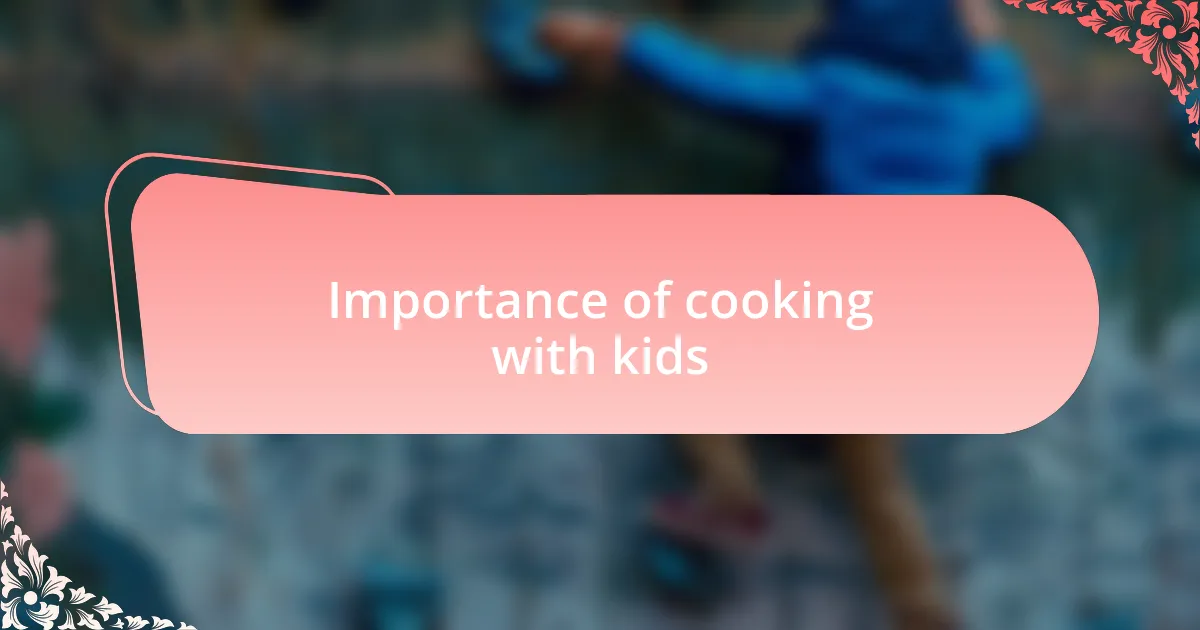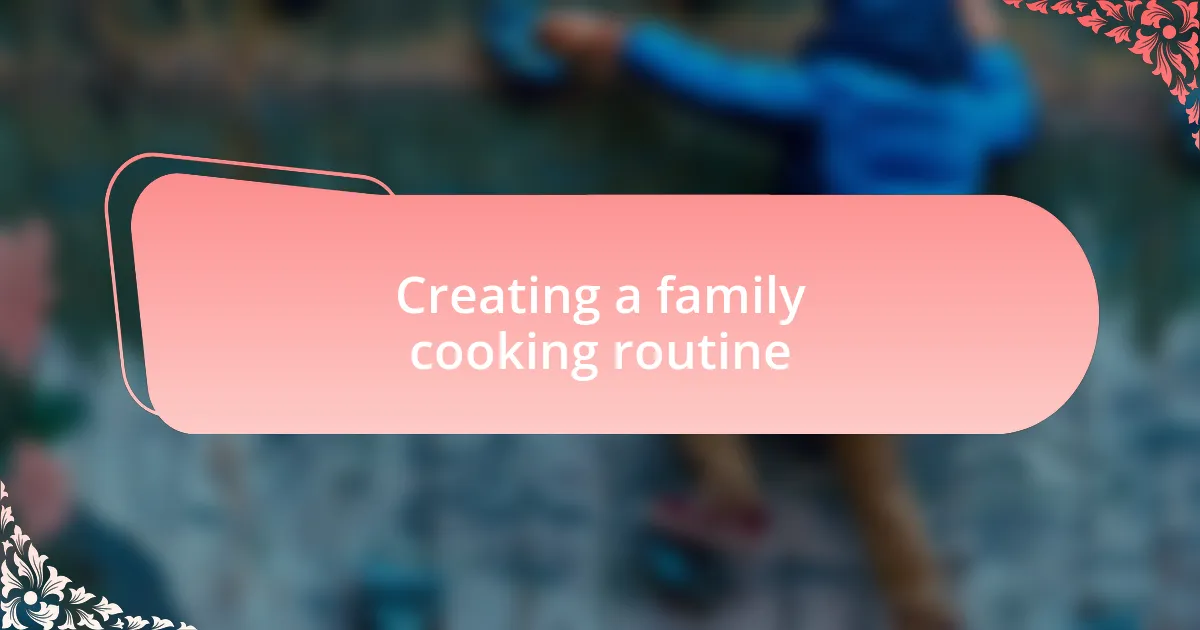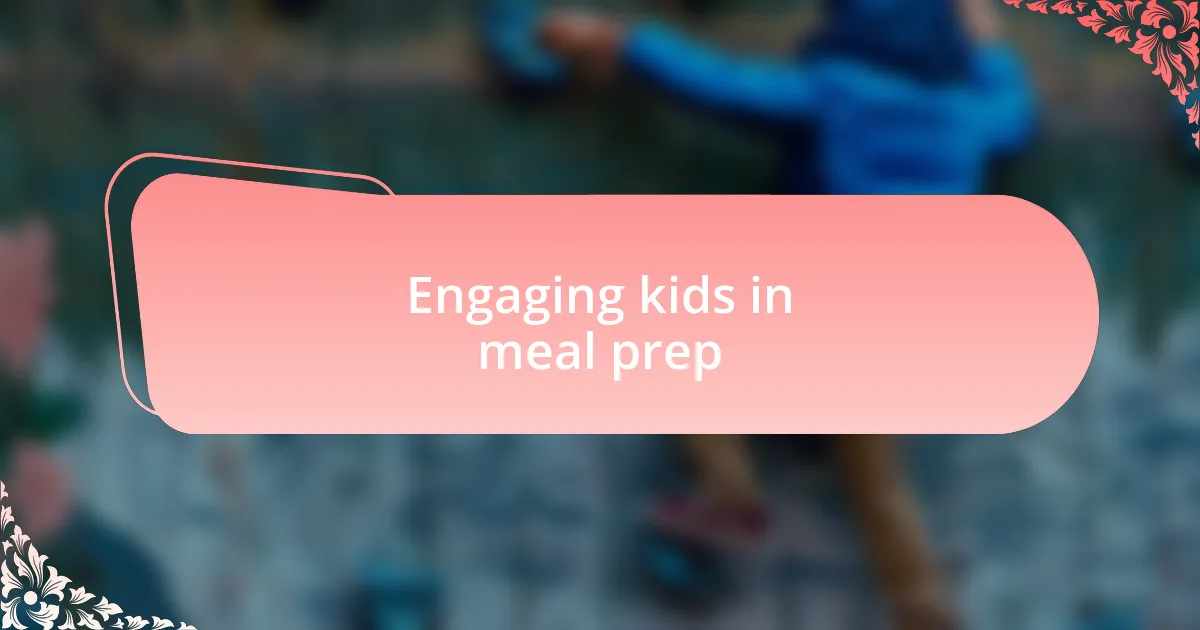Key takeaways:
- Cooking with kids enhances their nutritional knowledge, encourages trying new foods, and strengthens their relationship with food.
- Involving children in cooking builds confidence, fosters communication, and instills gratitude for food.
- Establishing a family cooking routine enhances bonding and creativity, making meals a cherished ritual.
- Sharing cooking experiences and stories enriches family connections and fosters creativity, decision-making, and storytelling skills.

Child health benefits of cooking
Cooking with kids can significantly boost their nutritional knowledge and awareness. When I cook alongside my children, I often see them making connections between food choices and their health. Have you ever noticed how a simple recipe can spark curiosity about where ingredients come from or how they impact our bodies? This learning experience helps children develop a healthier relationship with food.
Engaging kids in the cooking process also encourages them to try new foods. I remember a time when we made homemade pizza together; my daughter surprised me by tasting spinach for the first time, simply because she helped prepare it. When kids are involved, they feel a sense of ownership over their meals, making them more likely to enjoy diverse flavors and healthier options.
Moreover, cooking together provides a fantastic platform for developing essential life skills. I’ve observed how measuring ingredients enhances my children’s math skills and how following recipes fosters patience and focus. These moments not only contribute to their physical well-being but also enrich their cognitive and emotional development, nurturing a sense of accomplishment with every dish we create.

Importance of cooking with kids
Cooking with kids isn’t just about meal prep; it’s a wonderful opportunity for bonding and communication. I remember a weekend when my son and I decided to bake cookies. As we mixed the dough, we chatted about his week at school. Those conversations flowed naturally, weaving our relationship tighter. Have you found that sharing kitchen moments can create a safe space for kids to express themselves?
Involving children in cooking also boosts their confidence. The first time my daughter cracked an egg, she beamed with pride. It was a small step, but for her, it felt monumental. This sense of achievement builds self-esteem and encourages them to tackle challenges beyond the kitchen. Can you recall a moment when seeing your child succeed made your heart swell with joy?
Additionally, cooking together can instill gratitude and appreciation for food. I once took my kids to the local farmer’s market, where they picked fresh vegetables we later used in our dinner. Their excitement for cooking with ingredients they hand-selected was palpable. It made them think about where food comes from and how much effort goes into bringing it to our table. Have you considered how such experiences can help children value their meals more?

Creating a family cooking routine
Establishing a family cooking routine can turn mealtime into a cherished ritual. For instance, my family designates Sunday afternoons for trying out new recipes together. This habit not only fills our home with delightful aromas but also sets a positive tone for the coming week. Have you ever noticed how gathering around the kitchen can instantly transform a regular day into something special?
Involving kids in planning meals can also be a game changer. I remember when my son enthusiastically suggested taco night, complete with colorful toppings. His excitement was contagious, and it sparked a whole discussion about different flavors and cultures. How do you think letting kids have a say in meal choices affects their willingness to try new foods?
Additionally, consistency is key. Creating a specific day or evening for cooking as a family helps everyone know what to expect. I’ve found that when we stick to our routine, the children eagerly anticipate our cooking sessions, often coming up with their own ideas for the next meal. Have you seen how structured time together can lead to more creativity and enthusiasm in your kids?

Choosing healthy recipes together
When it comes to choosing healthy recipes together, I’ve discovered that involving my kids in the selection process makes them more excited about cooking. One afternoon, we flipped through a healthy cookbook and stumbled upon a colorful quinoa salad that looked like a rainbow on a plate. The moment they picked it out, their eyes lit up with enthusiasm—who knew that letting them choose could have such a positive impact on meal times?
I also encourage my children to explore diverse cuisines when selecting recipes. For instance, we once decided to prepare a Mediterranean feast, which introduced not only chickpeas and olives but also sparked conversations about the cultures behind the foods. Engaging with different flavors keeps them curious and more open to trying something new. Have you ever seen how exploring recipes from around the world can open up a whole new culinary adventure for your family?
Lastly, I’ve learned that creating a recipe chart can make the process more interactive. We fill it with healthy options that my kids have chosen, preventing meal fatigue and ensuring we’re on track for nutritionally balanced meals. When they can see their choices being cooked, it fosters a sense of pride and accomplishment. Isn’t it amazing how a simple chart can motivate kids to embrace healthier eating habits?

Engaging kids in meal prep
Engaging kids in meal prep opens the door to a world of creativity. I remember one weekend when my kids and I decided to create our own pizza. They loved rolling out the dough, and their laughter filled the kitchen when the dough flew off the counter. Watching them mix and match toppings not only sparked their imagination but also allowed them to experiment with flavors. Isn’t it wonderful to see them take ownership of their culinary creations?
Another time, we dived into the world of chopping vegetables. I handed them kid-safe knives and watched as they carefully diced bell peppers and cucumbers. They felt like true chefs, and I can still hear their proud exclamations of, “I did that!” It surprised me how such a simple task could ignite their confidence. Who knew that a little chopping could lead to such a big sense of accomplishment?
Involving my children in meal prep teaches them valuable life skills while strengthening our bond. While making a hearty soup, they took turns stirring and adding ingredients, asking me questions about each one. This not only encouraged their curiosity about nutrition but also fostered great conversations about where food comes from. Have you ever noticed how a shared cooking experience can transform your relationship with your kids while keeping meals fun and educational?

Making cooking fun and educational
Cooking together can be an incredible learning adventure for kids. I recall one afternoon when my daughter and I decided to bake cookies, and we used a measuring cup to show her how to follow a recipe. As she poured in the sugar, her eyes lit up with curiosity about how precise measurements could lead to sweet treats. Isn’t it fascinating how a simple act of measuring can teach kids about math and following directions?
Another memorable experience was when my son and I made homemade pasta. I found it delightful to see him delightfully kneading the dough while I explained the science behind gluten formation. That moment sparked a conversation about the origins of pasta and different cuisines around the world. It really made me appreciate how cooking can bridge gaps between subjects like science and geography, doesn’t it?
I often let my kids take the lead in selecting ingredients from the garden or the grocery store. This not only makes them excited about the food they prepare but also teaches the importance of making healthy choices. Watching them deliberate over fresh vegetables, asking questions like, “What can we make with these?” reinforces their critical thinking skills. Isn’t it empowering to watch them discover that food can be both nourishing and fun to make?

Sharing cooking experiences and stories
Sharing cooking experiences can ignite a passion for food that lasts a lifetime. I remember when my daughter decided she wanted to recreate a dish from a favorite family restaurant. As we flipped through the recipe book, her excitement turned into a hilarious competition over who could chop vegetables faster. That playful rivalry not only made cooking enjoyable, but also turned an ordinary dinner into a cherished memory we often laugh about. Isn’t it amazing how such moments can strengthen our relationships while we bond over creating something delicious?
I’ve found that sharing our culinary tales creates a unique atmosphere at the dinner table. One evening, after preparing a hearty soup, my son enthusiastically started to tell stories about when he accidentally dropped a whole bag of flour on the kitchen floor during a past baking adventure. As we reminisced about that moment, the laughter that erupted filled the room, and it felt like we were not just sharing a meal, but also weaving a tapestry of our cooking journey together. Isn’t it funny how cooking blunders can become the highlights of our family lore?
Reflecting on our shared cooking experiences, I realize they have created lasting lessons beyond just recipes. Last week, I had my kids pick their favorite meals and share what they thought made them special. As they articulated their choices, it struck me how this simple exercise nurtured their storytelling and decision-making skills. Each dish came alive with anecdotes from family gatherings or holiday traditions, emphasizing the power of food to evoke nostalgia. How wonderful it is that preparing and sharing meals can foster creativity and a sense of belonging in our family?